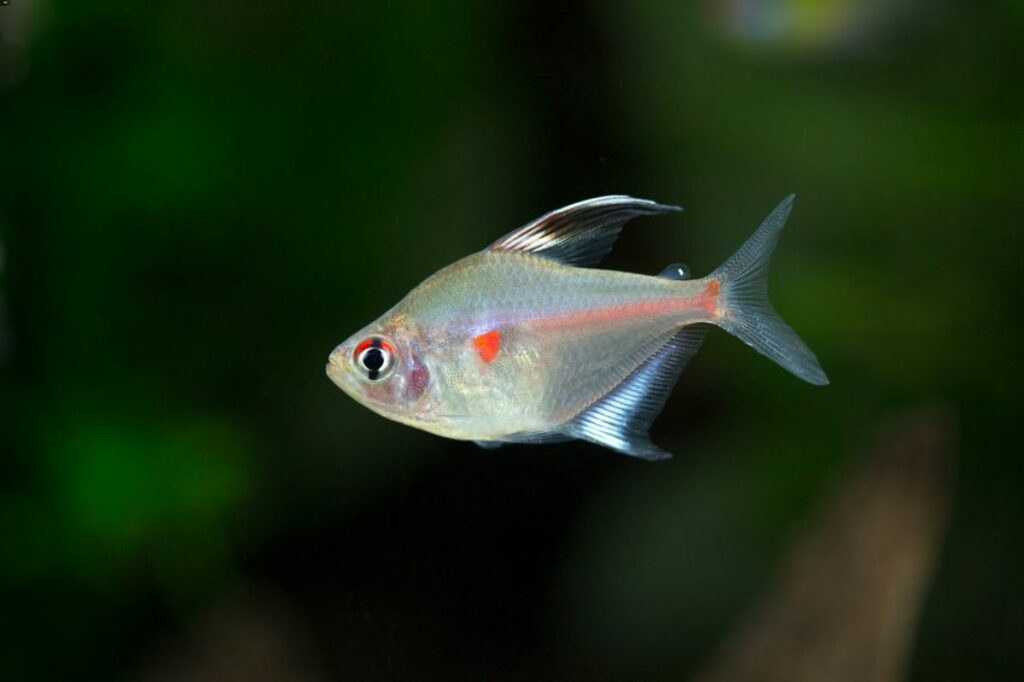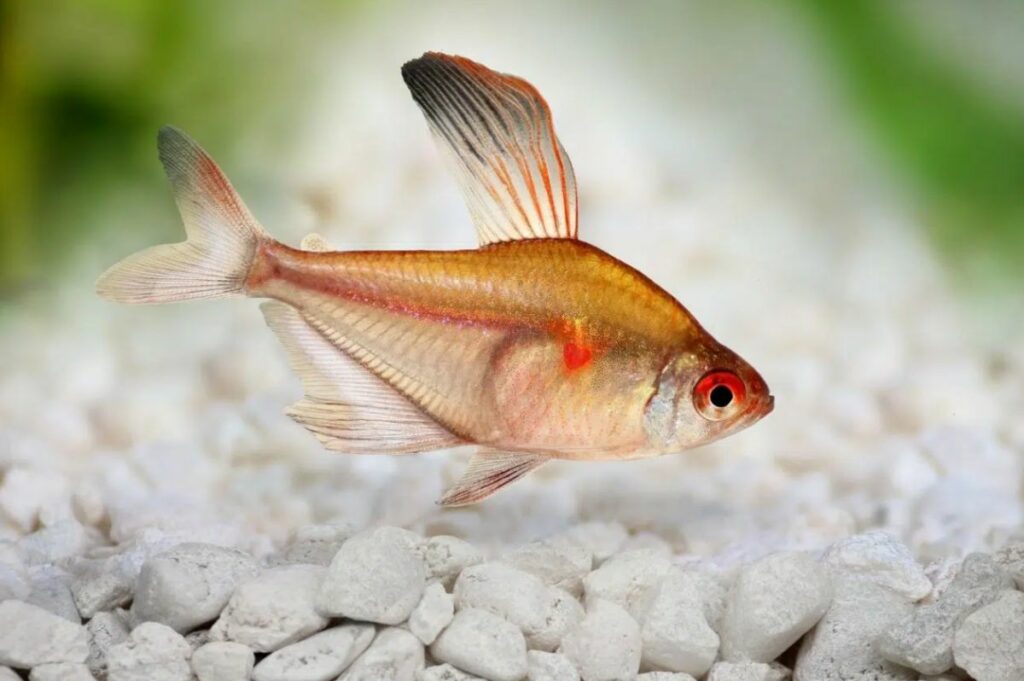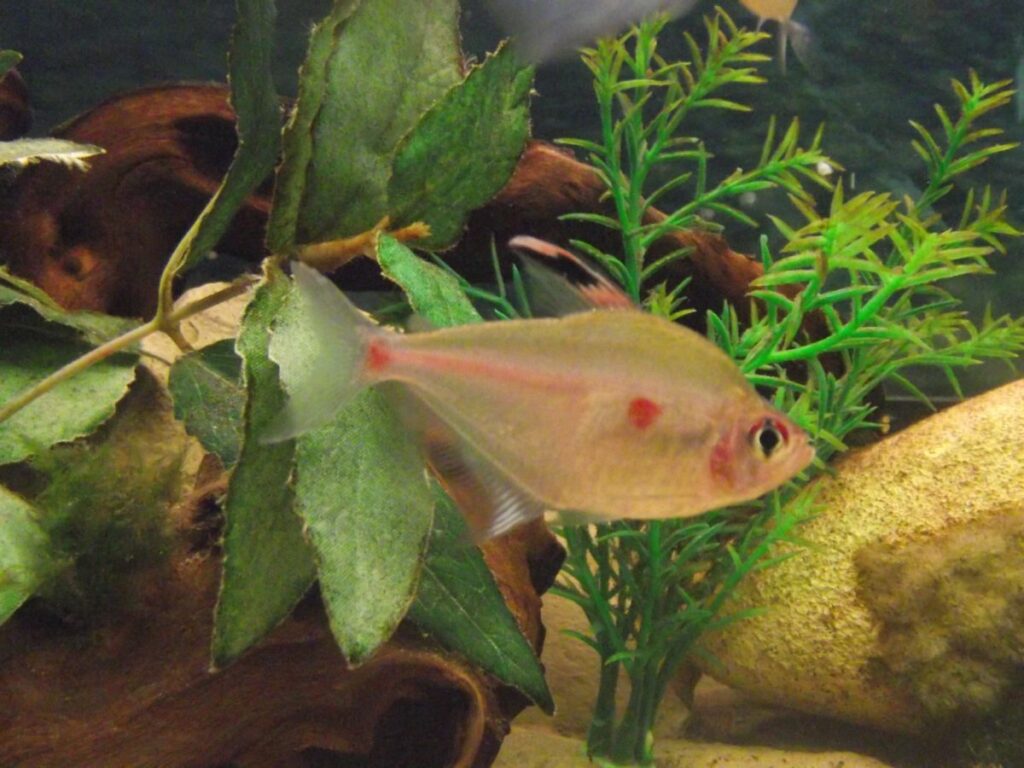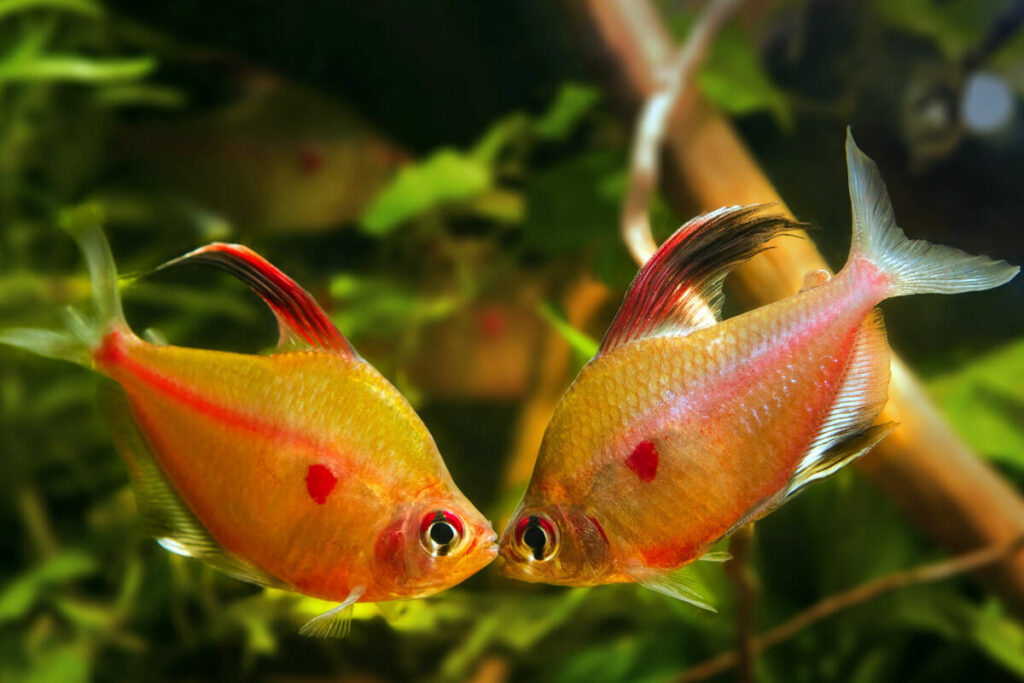One look and it’s easy to see how the bleeding heart tetra gets its name. The red dot along its flank looks like an actual heart. That, along with its natural long fins, makes it an interesting choice for a mixed community tank. So what is involved in caring for the bleeding heart tetra?

What is the Bleeding Heart Tetra?
Bleeding heart tetras are a larger species of tetra fish. Both in terms of their overall length as well as their body build. These tetras have a chunkier body compared to the slim forms most aquarists recognize in neon tetras or glowlight tetras.
There is a second species that sometimes enters the trade: the lesser bleeding heart tetra or spotfin tetra (Hyphessobrycon socolofi). The differences are subtle as both species share similar colors, adult size, and even finnage.
One sure way to tell is to examine the anal fin of the adult males. True bleeding heart tetras have white that extends into the hook shape of the anal fin. While spotfin tetras show less white.
- Common Name: Bleeding Heart Tetra
- Scientific Name: Hyphessobrycon erythrostigma
- Origin: Upper Amazon River basin
- Length: 2 to 3 inches
- Tank Size: 20-30 gallons
- Temperament: Peaceful; Schooling
- Ease of Care: Moderate
Bleeding Heart Tetra Care
Since most bleeding heart tetras are wild caught they are a little more sensitive to poor water quality. Otherwise they are a good tetra to keep, even for beginners who are diligent about aquarium maintenance.
Bleeding Heart Tetra Size
As a medium sized community fish, a school of bleeding heart tetras are a good addition to mid-sized aquariums. When young, a handful will be okay in a 10 gallon tank for months.
But once they reach 2 inches in length, your tetras should be upgraded to at least 20 gallons of space. Some bleeding heart tetras will grow up to 3 inches long, making 30 gallons a true minimum.
And like all tetras these are schooling fish. Never keep a bleeding heart tetra alone; it will hide all of the time and could even die of loneliness. Tetras live in schools of hundreds of fish in the wild. Without their own kind around they fade in color and become insecure. 6 bleeding heart tetras is the fewest you should own, with more being better.
Plants and Substrate Choices

Live plants are excellent choices for a bleeding heart tetra tank. Plants do more than look beautiful. They absorb carbon dioxide and release oxygen for your fish. Aerating the tank in the process.
Plants also use nitrogenous waste (ammonia, nitrite, and nitrate) as fertilizer. Pollutants that are dangerous to fish health, including bleeding heart tetras. The lusher you create your underwater garden, the better. Bleeding heart tetras are also egg scatterers and need plants for spawning.
If you want to replicate their natural habitat, use a sand bottom with plants that do well in it. Species with fine roots are able to grip sand substrates securely. Patches of shade ranging from light to heavy complete the picture.
Use a mixture of floating and submerged plants, with ample leaf litter along the aquarium bottom. Indian almond leaves are excellent for this purpose. They are rich in plant tannins, which lower the pH.
That said, they also stain the water a tea color if used in large amounts. If you’re going for a true biotope tank then that’s what you want. Bleeding heart tetras are blackwater fish. Their native streams are often coffee-colored and the pH is low. Driftwood also contains tannin, with the content depending on the variety you choose.
Water Conditions for Tetra Bleeding Heart
Soft, acidic conditions are required if you want your bleeding heart tetras to have a long lifespan. They will live up to 5 years if well cared for. But one way to shorten this lifespan is to keep them in hard, alkaline water. The kind of water that comes out of the tap in most countries.
A pH range of 4.0-7.0 is ideal. There are a few ways you could achieve this. Try adding plant based tannin sources like peat, driftwood, and Indian almond leaves to lower the pH. Plant tannins also come bottled for more precise dosing.
Some aquarists also use reverse osmosis or distilled water for filling the tank. And for performing water changes during maintenance. R.O. and distilled water are mineral-free and have a neutral pH (7.0). Even small amounts of tannins will cause the pH to lower.
Be careful when using these mineral-free sources. The pH may swing fast if you accidentally add other water chemistry affecting agents. Which will cause your fish severe stress.
Nitrogenous waste levels need to be kept low. Ammonia and nitrite are toxic to bleeding heart tetras and they will be the first fish to show stress if levels remain high. Nitrate levels of 5 to 10 parts per million are suitable for plant fertilizer. But don’t let levels creep higher than this.
Water flow should be low to moderate as bleeding heart tetras live in slow moving regions of streams and rivers.
What Do Bleeding Heart Tetras Eat?

Bleeding heart tetra fish are omnivores, feeding on aquatic insect larvae, fallen fruit, soft plants, worms, and fish fry. They may nip at soft leaved aquarium plants but tetras offered a varied diet will leave them alone.
Since your tetras are wild caught, see if they have already been weaned onto prepared food. That will make your job much easier as wild caught fish will sometimes die before learning to eat flakes and micro pellets.
Supplement this diet with a mixture of fresh and frozen foods. Brine shrimp, blood worms, tubifex worms, and daphnia are good sources of animal protein. Small pieces of soft fruit, lettuce, and other vegetation should be clipped to the glass once per week.
Feed your bleeding heart tetras 2 to 3 times per week. As much as they will eat in 2 to 3 minutes.
Bleeding Heart Fish Tank Mates
Bleeding heart tetras are peaceful and sociable with each other. Given their size, you should keep them with aquarium fish around their own size. Sometimes they will nip the fins of slow moving tank mates like bettas and angelfish. So stick to fish with normal finnage.
Also consider their need for acid conditions. Livebearing fish are a good match in terms of temperament and diet. But their need for hard, alkaline water excludes them from living alongside bleeding heart tetras.
Other tetra fish are a good place to look for tank mates. As well as most other Amazonian native fish. These include cory catfish, Apistogramma sp. dwarf cichlids, severums, and bristlenose plecos.
Several Southeast Asian fish also enjoy the same water conditions. Dwarf gouramis, pearl gouramis, kuhli loaches, and clown loaches all get along fine with bleeding heart tetras.
Invertebrate tank mates should be chosen with care. Bleeding heart tetras will eat most dwarf shrimp but larger species will be safe. Snails may work but their long, sensitive antenna and eye stalks may be targets for nipping.
Breeding the Tetra Bleeding Heart

Bleeding heart tetras are not an easy fish to breed. The only way to do so is to follow everything you’ve read so far in this guide. That means duplicating the precise water conditions, providing lush live plant growth, and a diet rich in variety.
You also need to tell the sexes apart, which is not easy to do. Male and female bleeding heart tetras are similar in size and color. A full grown male will be around 20% larger, however. His colors will also be a little brighter.
Males are also competitive with one another and spend much more time chasing and nipping at each other. And once a female becomes gravid (pregnant), she becomes significantly bigger. Plus the males will shower her with attention to try and mate with her.
Spawning the Bleeding Heart Tetra
As egg scatterers, bleeding heart tetra fish provide no parental care. The sticky eggs are deposited among live plants in the dawn or dusk hours.
Once they spawn you should move the attached eggs and plants to a fry rearing tank. Otherwise the parents will forget about their babies and eat them.
The fry will hatch in around 48 hours but don’t need to be fed at first. They subsist on their yolk sack and stay along the tank bottom. And signal that they are ready for solid food by swimming away from the bottom of the tank.
At this stage you should offer them live infusoria since brine shrimp nauplii are too large for them at first. After the first week of feeding them, you then switch to live baby brine shrimp and crushed flake food.
Conclusion
Bleeding heart tetras are a little more challenging to keep. Their need for pristine water that’s acidic in chemistry may be too difficult for beginner aquarists to maintain. But if you achieve this, these beautiful schooling fish are well worth the effort!
FAQs
Bleeding heart tetras aren’t as bad as black skirt tetras and some other larger tetras. But they will nip the fins of fish their own size or smaller. Bettas and fancy guppies are some of the worst fish to keep with these tetras.
Bleeding heart tetras are an excellent addition to a discus tank. Since they come from the same region of the world, they will thrive in the same acidic water conditions. Both fish species do well in black water tanks and need pristine water quality to do well.
I would not keep bleeding heart tetras with betta fish. The slow movement and long fins of bettas are too tempting for these teteras to ignore. And even moderate fin nipping may lead to its death.

